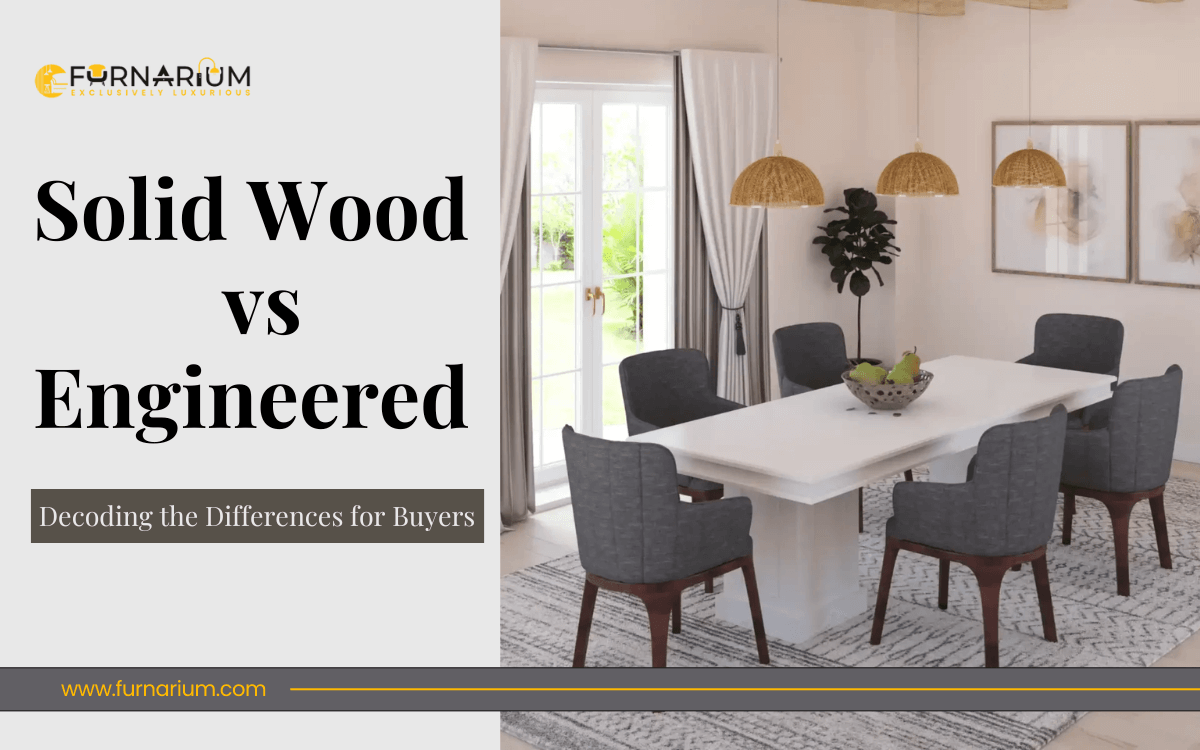When it comes to choosing the perfect furniture for your home, one of the most critical decisions revolves around the type of wood used. Solid wood and engineered wood are two popular options, each with its own set of characteristics and benefits. Understanding these differences is essential for making an informed decision that aligns with your lifestyle, budget, and sustainability values.
What is Solid Wood and Engineered Wood?
Solid Wood
Solid wood furniture is crafted from natural lumber, typically sourced from deciduous trees like oak, maple, and walnut, or coniferous trees like pine and cedar. This type of wood is prized for its durability, natural beauty, and unique grain patterns.
- Composition: Solid wood is composed entirely of lumber, with no fillers or adhesives.
- Characteristics: Each piece is unique, with natural variations in grain and color. It can be easily sanded and refinished, extending its lifespan.
- Manufacturing Process: The wood is cut directly from the tree, dried, and then shaped into furniture pieces.
Engineered Wood
Engineered wood, on the other hand, is made by binding together wood fibers, particles, or veneers with adhesives to form composite materials. Common types include plywood, medium-density fiberboard (MDF), and particleboard.
- Composition: Engineered wood consists of layers of wood veneers or fibers glued together.
- Characteristics: It offers a uniform appearance and can be designed to mimic the look of solid wood. It’s generally more resistant to warping and cracking.
- Manufacturing Process: Wood scraps and byproducts are bonded together under heat and pressure to create a stable and versatile material.
Advantages and Disadvantages
Solid Wood
Advantages:
- Durability: Solid wood is highly durable and can last for generations when properly maintained.
- Aesthetic Appeal: The natural grain and color variations make each piece unique.
- Refinishing: It can be sanded and refinished multiple times to restore its appearance or change its color.
Disadvantages:
- Cost: Solid wood furniture is generally more expensive due to the cost of raw materials and craftsmanship.
- Weight: It is heavier, making it less convenient to move.
- Susceptibility to Moisture: Solid wood can warp, crack, or swell when exposed to moisture and humidity.
Engineered Wood
Advantages:
- Cost-Effective: Engineered wood is typically less expensive than solid wood, making it a budget-friendly option.
- Stability: It is less prone to warping and shrinking, providing greater structural stability.
- Sustainability: Uses wood byproducts and reduces waste, making it a more environmentally friendly option.
Disadvantages:
- Lifespan: Generally, it has a shorter lifespan compared to solid wood.
- Refinishing Limitations: It cannot be sanded and refinished as many times as solid wood.
- Aesthetic Limitations: While it can mimic the look of solid wood, it may lack the authenticity and detailed grain patterns.
Use Cases and Recommendations
Whether you should choose solid wood or engineered wood depends on your specific needs and circumstances.
Solid Wood
- High-Traffic Areas: Ideal for dining tables, bed frames, and desks where durability is crucial.
- Heirloom Pieces: Perfect for furniture intended to be passed down through generations.
- Natural Beauty: Best for those who appreciate unique, one-of-a-kind pieces.
Engineered Wood
- Budget-Conscious Buyers: Great for those looking for affordability without sacrificing too much on quality.
- Temporary or Transitional Furniture: Suitable for furniture that may not need to last a lifetime, such as dorm room or rental property furnishings.
- Modern Aesthetics: Often used in contemporary designs where a uniform appearance is desired.
Sustainability and Environmental Considerations
Solid Wood
Solid wood is often considered more sustainable if sourced responsibly from well-managed forests. Look for certifications like FSC (Forest Stewardship Council) to ensure the wood is harvested sustainably. However, the environmental impact of deforestation can be significant if not managed properly.
Engineered Wood
Engineered wood makes use of wood byproducts and lesser-quality logs that would otherwise go to waste. This can reduce the overall environmental footprint. However, the adhesives and resins used in manufacturing can sometimes contain formaldehyde and other harmful chemicals, so it’s important to choose products with low or no added formaldehyde.
Conclusion
Both solid wood and engineered wood have their own set of advantages and drawbacks. Your choice will ultimately depend on your specific needs, budget, and values. If you seek durability, and timeless beauty, and are willing to invest, solid wood furniture may be the right choice. On the other hand, if affordability, stability, and sustainability are your priorities, engineered wood offers a compelling alternative.
Understanding the differences between these two types of wood allows you to make an informed decision that aligns with your lifestyle and values. In the end, the right choice will enhance your living space, providing both functionality and aesthetic pleasure for years to come.

